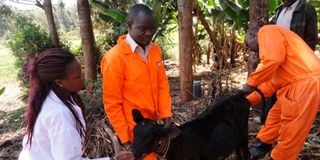With animal diseases, a stitch in time saves nine

Veterinary doctors vaccinate cattle against East Coast Fever (ECF) on a farm in Meru County in 2017.
One of my professors in vet school, many years back, told us that once we graduated as veterinary doctors, we would have to learn to separate leisure with business. I have also been told the same many times in work-life balance trainings over the course of my practice.
I do agree we all need some leisure and social time away from our occupations. It, however, becomes very difficult for some of the professionals like veterinary and medical doctors to completely block out work-related activities from one’s social and leisure times.
The good news though is that the times when a professional call of duty comes in the way of social and leisure time are few. But this is the time when a professional’s commitment to serve society is tested. In such cases, there may be no monetary exchange involved.
I visited a friend in Murang’a three weeks ago. And when it came to leaving, he requested I see his newly set up dairy unit. I honestly had deliberately avoided visiting the animals because health and production issues would definitely crop up.
Breed quality
The most common question I get from farmers I visit socially is to comment on the breed quality and production potential of the animals. That question is very loaded and generates a long engagement on breeds and their characteristics.
Anyway, I agreed to briefly view the animals. The farmer had started off well, even though he was keeping dairy cattle for the first time. He had five good Friesian cows. Two were in-calf with one due to calve down in about two weeks. The other in about two months.
The other three were heifers between six and nine months. I congratulated the farmer for staggering his animals in a way that he could get milk at different times of the year. He said his aim was to first understand how to take care of dairy cattle and later increase the numbers to about 20.
I found the animals were being fed with sweet potato vines which they relished but there was one heifer that would get to the feeding trough, sniff the feed lazily, attempt a bite and then walk away.
I also noticed the heifer looked rather unhappy and walked lazily. It was not as full as I would have expected at that time of the day. I drew the attention of my friend, Mwangi, to the heifer and asked him to bring the animal close to the fence so that I could examine it. It definitely was unwell.
Dry muzzle
The heifer was friendly and obedient. Mwangi told me he caressed his animals daily and talked to them. He called the heifer by name and coaxed it to stand against the fence. I was impressed by his command of the animal.
I briefly examined the heifer and observed it had a dry muzzle. I could tell by touch with the back of my hand the heifer had fever. Though the environmental temperature was 14 degrees Centigrade as I read from my phone, the animal’s fur and skin felt warm. I noticed the external glands of the hind legs, called the precrural glands, were swollen.
I informed the farmer the heifer was sick. Most likely, it was in the very early stages of East Coast Fever (ECF) disease. That was the furthest I could go without my drug kit. I advised him to call his animal health service provider immediately to attend to the animal.
Mwangi said he would report the animal the following day since it was already late in the day. I insisted he should report immediately. Waiting until the following day would diminish the chances of fast and uneventful response to treatment.
About two hours later, Mwangi’s paravet called me and confirmed the heifer had a high fever of 41 degrees Centigrade. He had treated the animal for ECF. Mwangi reported the following day the animal had shown very good and rapid response to treatment. He, however, wondered why other people’s animals took long to recover from the disease.
Mwangi’s question is a common one. Many people even believe cows treated for ECF still die anyway or they become unthrifty for a long time.
Exotic breeds
The answer lies in the nature and progression of the disease and sometimes the disease coming in combination with others.
ECF is a disease of cattle caused by a malaria-like blood parasite that is spread by ticks. Exotic breeds of cattle such as Friesians are highly affected by the disease but indigenous Zebu are fairly resistant if they have been continuously exposed to the disease.
The disease is seen in the early stages as I observed in Mwangi’s heifer. Milking cows will, in addition, have a drastic drop in yield. At that stage, few parasites have entered the animal’s blood stream. It is the best stage at which to treat the disease before it starts damaging vital organs.
If the disease progresses untreated, the parasites multiply very quickly and cause destruction of the lungs and heavy production of fluids into the lungs. The animal takes a long time to heal or dies anyway even after treatment.





